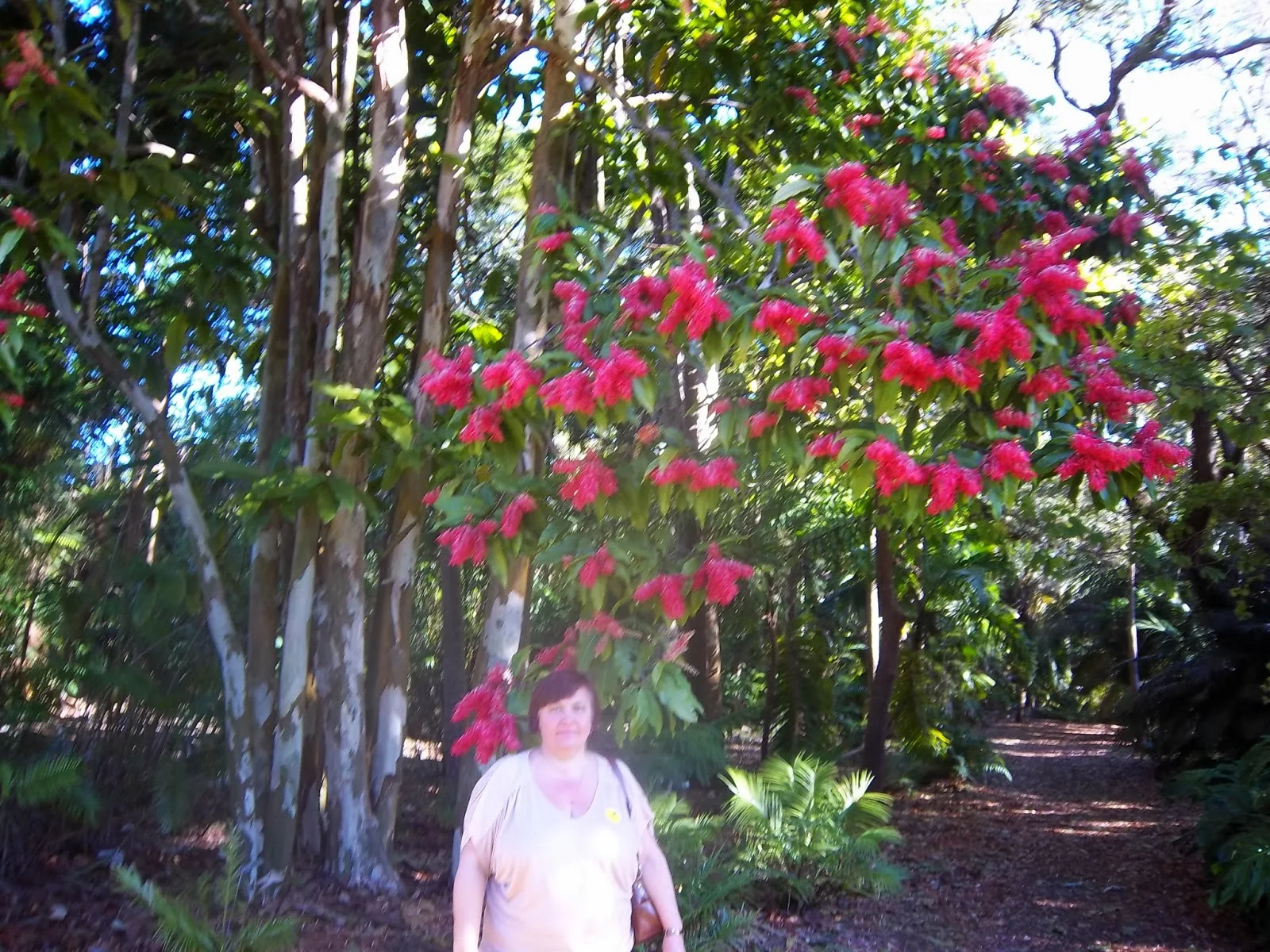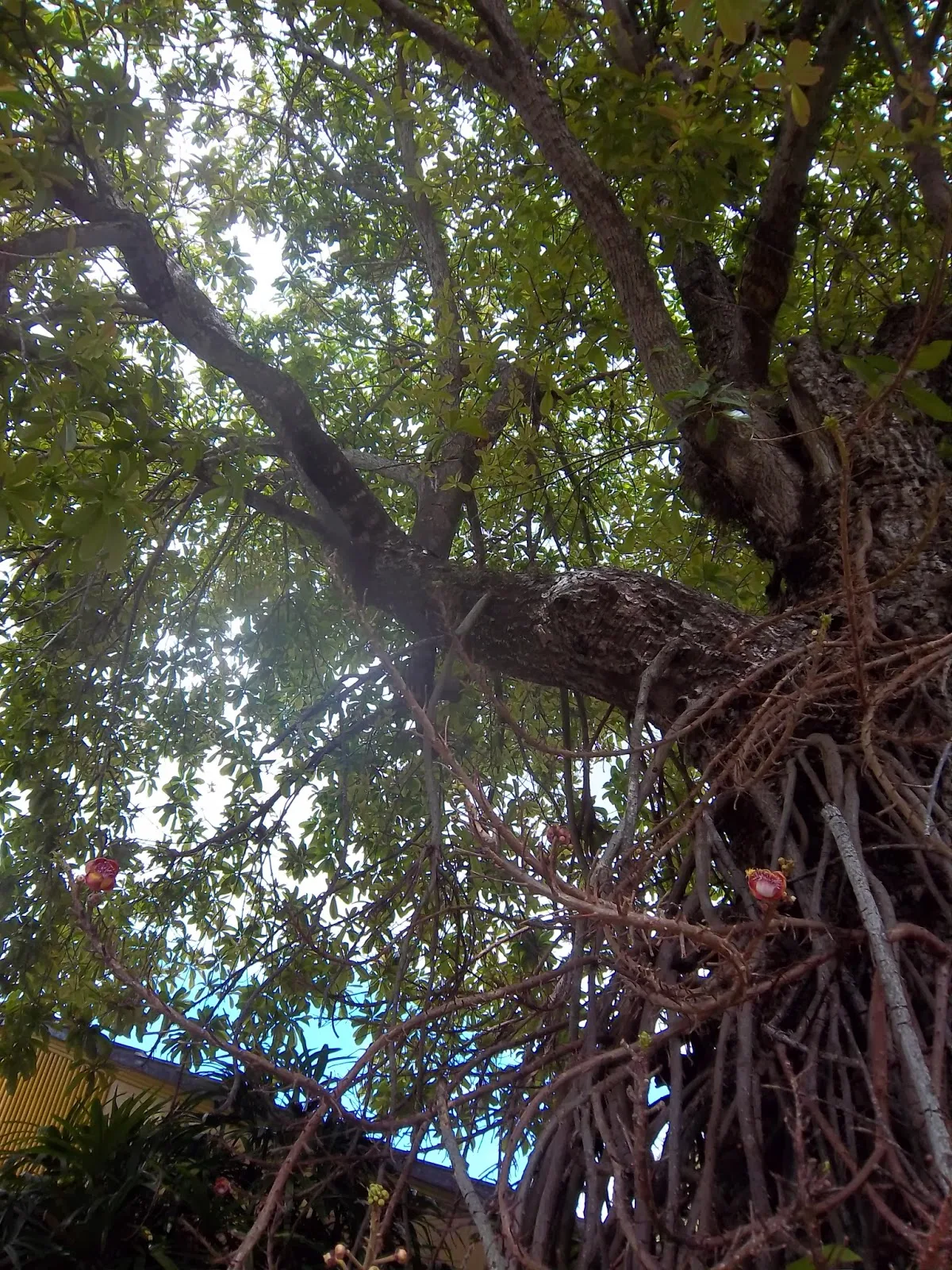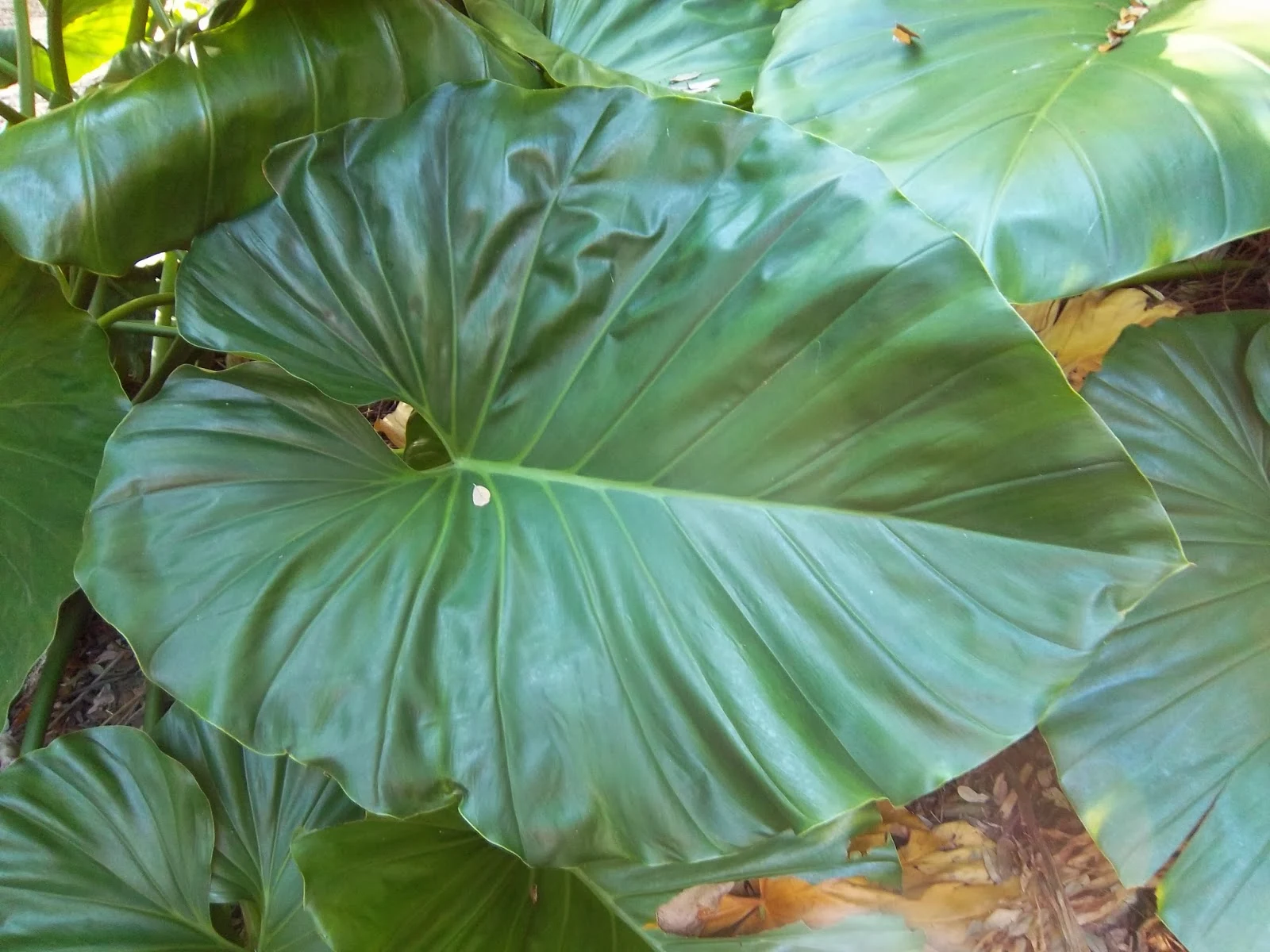By Liliana Usvat
Blog 143 -365
Tree ferns are perfect for what may be your more difficult garden areas
because they prefer shady, sheltered and moist locations.
Tree ferns do like neutral to acidic humus-rich soil, so our alkaline
rocky gardens might need supplementing, preferably with compost. To
encourage root growth, avoid fertilizing your fern during its first year.
Read more here: http://www.miamiherald.com/2013/07/30/3531442/tree-ferns-bring-tropical-australia.html#storylink=cpy
Read more here: http://www.miamiherald.com/2013/07/30/3531442/tree-ferns-bring-tropical-australia.html#storylink=cpy
Fairchild Tropical Botanic Garden has many on display, including the Australian tree fern (
Cyathea cooperi), Hawaiian tree fern
(Cibotium glaucom), Mexican tree fern
(C. schiedei), Caribbean tree fern
(Cyathea arborea) and the rare native Florida tree fern
(Ctenitis sloanei).

Australian tree ferns can grow to about 20 to 30 feet tall and 10 to15
feet wide. Trunks can grow to about one foot in diameter. They are
usually inexpensive, so if you have the proper space, try growing one of
these lacy, languid plants
Read more here: http://www.miamiherald.com/2013/07/30/3531442/tree-ferns-bring-tropical-australia.html#storylink=cpy
Read more here: http://www.miamiherald.com/2013/07/30/3531442/tree-ferns-bring-tropical-australia.html#storylink=cpy
In general, any fern that grows with a trunk elevating the fronds
(leaves) above ground level can be called a tree fern. However, the
plants formally known as tree ferns comprise a group of large ferns
belonging to the families Dicksoniaceae and Cyatheaceae in the order Cyatheales.

Tree ferns are found growing in tropical and subtropical areas, as well as temperate rainforests in South Africa, Australia, New Zealand, and other island groups nearby; a few genera extend further, such as
Culcita in southern Europe. Like all ferns, tree ferns reproduce by means of spores developed in sporangia on the undersides of the fronds.
The number of tree fern species is likely to be around a thousand. Although new species are discovered in New Guinea with each botanical survey, many species throughout its range have become extinct in the last century as forest habitats have come under pressure from human activity.
Ferns - Medicinal uses in New Guinea
Fevers, headaches, colds, etc.: Blackwood (1935) mentions
that in Bougainville,
Selaginella flabellata is used to control
feverish headaches and menstruation. The leaves are applied externally
and the roots taken internally. In the Mt Hagen area the petiole sap of
the common bracken
Pteridium aquilinum is used to treat toothache
and mouth infections (Powell 1976b). For colds
Cyclosorus leaves
are used in the Northern Province and for nasal infections the smoke of
a species of
Polypodium (=?) is inhaled in Mt Hagen (Powell 1976b).
Boils, ulcers, wounds: In east New Britain, Futscher (1959)
reports
Gleichenia linearis (=
Dicranopteris linearis) being
bound externally onto wounds. On Bougainville, Blackwood (1935) reports
the leaves of
Pteris ensiformis and
Aspidium latifolium (=
Pronephrium
menisciicarpon, but possibly a species of
Tectaria) and the
leaves and roots of
Dryopteris milneana being applied to boils,
ulcers and arrow wounds. The last two species are probably misidentified.
Holdsworth (1980) gives a review of Blackwood's medicinal plant results.
In the Northern Province a species of
Athyrium
is used to treat sores and in New Britain a poultice of boiled fronds of
a species of
Cyclosorus is used for the same purpose (Powell 1976b).
Hot fronds of a species of
Polystichum are applied to groin swellings
in the Mt Hagen area (Powell 1976b). In Morobe Province, a poultice is
prepared from
Pityrogramma calomelanos for an unspecified purpose
Stomach pains: Holdsworth & Giheno (1975) record that
a species of
Lycopodium is chewed in the central highlands to induce
vomiting after food poisoning or acute stomach pain. For stomach ache and
diarrhoea, in the eastern highlands they report the chewing of fresh fronds
of
Lygodium longifolium with ash salt ( from
Asplenium acrobryum
or from the grass
Coix gigantea).
Menstruation, childbirth, contraception: Pteris tripartita
is used in childbirth in Bougainville, the fronds being taken internally.
Pteris ensiformis is used to control menstruation, as is
Selaginella
flabellata.
Lygodium dichotomum is used as a contraceptive,
the root and stem being taken internally; it is also used to treat children's
illnesses (Blackwood 1935). Peekel (1910) records a species of
Dryopteris
(most likely to be a species of
Thelypteridaceae) being used in
New Ireland as an abortifacient (Holdsworth, Hurley & Rayner 1979),
however he does not mention the species in his illustrated flora of the
island (Peekel in press, ms. completed c. 1947). In the Koiari area of
the central province of Papua New Guinea Holdsworth et al. (1980b) note
that total sterility in women can be achieved by eating the new leaves
of
Blechnum orientale each day for three successive days, waiting
a fortnight and then repeating the treatment.
Diseases: Holdsworth (1974) reports that on Dobu Island
in the D'Entrecasteaux Archipelago, a sorcerer claims to cure leprosy with
a draught prepared by shaking the crushed leaf of a species of
Lygodium
in water.
Native uses: According to Gunther: Rhizome is roasted by the Makah, peeled, chewed and the juice swallowed
for coughs; Cowlitz crush the rhizome, mix it with young fir needles, boil it, and drink the infusion for measles; the Quinault either bake the root on coals or use it raw as a cough medicine. Chewed for flavour and used as
medicine for colds and sore throats; also used with bitter medicine as a sweetener (Pojar). Method: Strong Decoction from rhizomes, 2-4 ozs, up to 3x daily (Moore); make Licorice
syrup by adding honey to the decoction (Tierra).
Cherokee used Maidenhair for
rheumatism (the
effect on contracted muscles likened to the uncurling fiddleheads)- the
compound decoction or decoction of root applied with warm hands as
external rub, or infusion internally. Infusion or decoction of whole
plant was used as an
emetic for fever and ague (fever with chills).
Powdered leaves are smoked for heart trouble and snuffed or smoked for
asthma.
They used it for paralytic attacks, as from pneumonia in children.
Sacred preparation of whole plant was used specifically for women’s
irregular heartbeat.
Cherokee considered Maidenshair a powerful
medicine for the
heart, and as such it is associated with the direction of East.
Costanoan of California used the decoction to
purify the blood and for stomach troubles.
Hesquiat of western Canada mixed the ashes in formula for shortness of
breath, and to produce strength and endurance. They likewise used the
green fronds.
The northwestern Makah chewed the fronds for weak
stomach.
Menomini (Wild Rice People) used a compound decoction of the root for
dysentery.
They used the blade, stem, and root in
gynecology.
Micmac, Algonquian of eastern Canada, used in decoction for fits.
Potawatomi of the upper Mississippi River used an infusion of the root
for caked breasts.
Natives applied poultice of plant to sore back of
babies. Wet fronds poulticed for
snakebite.
- Decoction used as wash for venereal disease such as gonorrhea.
- Used topically by Native Americans as a poultice or wash for bleeding,
- insect stings,
- snakebites,
- arthritis, and
- for hair.
- Hesquiat use of Maidenhair for endurance played out in ceremonial dancing, for which the infusion would be used, especially in winter, to prevent fatigue.
- Such uses along with the sacred preparation practiced by the Cherokee
indicate that this beautiful fern was regarded as a sacred medicine.
- Additionally, the black stems of Maidenhair were used by Potawatomi as a
hunting charm.
- The subspecies pedatum was used by the Iroquois for children’s cramps, as decoction.
- A compound decoction of the green roots used as a foot soak for rheumatism and taken internally.
- Decoction of pedantum roots taken as a diuretic for the cessation of urine due to stones.
- Compound decoction or infusion taken for excessive menstruation.
- Decoction of roots used to bring on menses and for abortion.
- Plant
used for abortion or delivery pains.

- Therefore, Maidenhair is anti-rheumatic, emetic, diaphoretic, cardiotonic, stimulant, alterative, astringent, antispasmodic, emenagogue, and antiseptic. Energetically, Maidenhair appears dry and cool, with an affinity for the heart and reproductive system.
- Iroquois used subspecies virginianum as a cough medicine for tuberculosis as cold infusion of root. Botrychium virginianum RATTLESNAKE FERN
- The Algonquian (northeast) Abnaki used as a demulcent and for children’s medicine. Cherokee used root decoction as emetic and as concentrated syrup for external use on snakebites
(including from dream snakes), and used the juice from the frond for
insect bites and stings. Botrychium virginianum RATTLESNAKE FERN
- Chippewa used a poultice of fresh root for
snakebite and as a repellant. Chicksaw (southwest) used as a diaphoretic and expectorant, and the root decoction as emetic. Ojibwa used for lung trouble, such as tuberculosis; and used the poulticed root on cuts. Potawatomi also used medicinally.
- Cherokee used in compound infusion for chills.
- Mahuna used for lung hemorrhages. Dennstaedtia punctilobula HAY-SCENTED FERN
- Dryopteris campyloptera MOUNTAIN WOOD FERN Cherokee used with tree bark for cuts and other skin problems. Considered medicine of the South.
- Dryopteris campyloptera MOUNTAIN WOOD FERNInuits used leaves in compound decoction for stomachache and
intestinal discomfort. Hesquiat used young shoots for cancer of the
womb.
Native American medicinal uses of ferns can be
categorized into five major groups: those used
- for rheumatism,
- those
used for the lungs,
- those used for gynecology,
- those used for the blood,
and
- those used for digestion.
Ferns used for Rheumatism
- Maidenhair (Adiantum pedatum) used for rheumatism.
- Marginal Wood Fern(Dryopteris marginalis) used for rheumatism.
- Sensitive Fern (Onoclea sensibilis) used for arthritis.
- Cinnamon Fern (Osmunda cinnamomea) used externally for rheumatism and internally for joint pain.
- Christmas Fern (Polystichum acrostichoides) used for rheumatism.
- Bracken Fern (Pteridium aquilinum) used for rheumatism.
Ferns used for Lungs
- Maidenhair smoked for asthma.
- Maidenhair Speenwort (Asplenium tricomanes) used for coughs.
- Rattlesnake Fern (Botrychium virginianum) used as a cough medicine for tuberculosis.
- Hay-scented Fern (Dennstaedtia penctilobula) used for chills and lung hemorrhages.
- Rock Cap (Polyopdium virginianum) used for sore throat, colds, measles, tuberculosis, cough, and lung congestion.
- Christmas Fern used for chills, fever, pneumonia, red spots on skin, listlessness, tuberculosis, and hoarseness.
- Bracken Fern used for tuberculosis, infections, and chest pain.
Ferns used for Gynecology (including menstrual, postpartum, and breastfeeding)
- Walking Fern (Asplenium rhizophyllum) used topically and as emetic for swollen breasts.
- Maidenhair Speenwort used for irregular menses and breast diseases.
- Lady Fern (Athyrium filis-femina)used for mothers with intestinal fevers and to prevent water breaking.
- Mountain Wood Fern (Dryopteris campyloptera) used for disease of the womb.
- Ostrich Fern (Matteuccia struthiopteris) used as decoction of sterile leaf stalk base for the expulsion of afterbirth and for back pain.
- Sensitive Fern (Onoclea sensibilis)
used for infection, blood disorders (blood deficiency, cold in the
blood, and others), and to restore the female system after childbirth.
Externally used for sores.
- Cinnamon Fern used for women’s troubles, caked breasts, and malaise.
- Interrupted Fern (Osmunda claytoniana) used for weak blood and gonorrhea.
- Royal Fern (Osmunda regalis) used for menstrual problems.
- Bracken Fern used for weak blood, uterine prolapse, suffering after birth, caked breast, weakness, and headaches.
- Marsh Fern (Thelypteris palustris)used as a gynecological medicine.
Ferns used for the Blood
- Maidenhair used as a wash or poultice for bleeding.
- Lady Fern used for vomiting of blood.
- Hay-scented Fern used for lung hemorrhages.
- Sensitive Fern used for blood deficiency, cold in the blood, and other blood disorders.
- Christmas Fern used for weak blood and toxic blood.
- Interrupted Fern used for weak blood.
- Bracken Fern used to make good blood after menses or childbirth.
Ferns used for Digestion (including stomachache and parasites)
- Mountain Wood Fern used for stomachache.
- Crested Wood Fern (Dryopteris cristata) used root infusion for stomach trouble.
- Royal Fern used for intestinal worms.
- Rock Cap used for stomachaches and cholera.
- Christmas Fern used for stomachache, bowel problems, toothache, cramps, and diarrhea.
- Bracken Fern used for diarrhea, nausea and vomiting, infections, diarrhea, weakness, stomach cramps, and headaches.
- Sensitive Fern used for intestinal troubles.
Other uses of Tree Ferns
Australian tree fern is a popular ornamental in temperate areas. The
pith from the centre of the trunk is rich in starch, and was once used
as food by Tasmanian Aborigines. The uncurled leaves (croziers) are also
edible, but have a slimy, sometimes bitter taste. The trunks are often
used as a medium for growing epiphytes, particularly orchids. Trunks can
also be used for fencing, while the central vascular material has been
dried and carved to make craft items such as bowls and plant pots.



























 (anthopogon hypenanthum)
(anthopogon hypenanthum)
 (Rhdodendron_campanulatum)
(Rhdodendron_campanulatum)


















 Papaia Flower
Papaia Flower


































